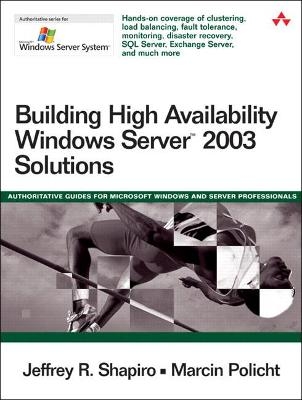
Building High Availability Windows Server 2003 Solutions
Addison-Wesley Educational Publishers Inc (Verlag)
978-0-321-22878-9 (ISBN)
Over the last year many companies and government organizations beganmigrating from platforms such as UNIX to the Windows 2003 platform tohave a high performance system that is available 24X7. However, theseorganizations face a huge learning curve on how best to set up highperformance Windows Server 2003 networks for maximum availability andpower. This book provides a clear and concise road map on keeping systemsup 24X7 with the Windows platform. It delves into topics that explain how touse Windows Server 2003 technology for scalability, uptime, performance, andmanagement, and how to avoid getting in trouble at the same time. This bookanswers questions network administrators ask such as, "Should we cluster, loadbalance, or both? Or should we invest in hot standbys? What works best?"After providing answers, Shapiro goes beyond discussing failover and faulttolerance to explaining monitoring, disaster recovery, and choosing the righttechnology to achieve maximum availability and high performance. This is thefirst book that not only provides thorough coverage of core clusterconfiguration and load balancing, but also explains how to maintain andadminister a Windows 2003 high performance system, and restore and recoverfailed servers in the event of a disaster.
Building High Availability Windows Server™ 2003 SolutionsAbout the Authors Jeffrey R. Shapiro has worked in Information Technology for nearly 15 years. He is an industry-celebrated author and has published more than a dozen books on IT, network administration, and software development. Jeffrey has written for numerous publications over the years as well. He also regularly speaks at events and frequently participates in training courses on Microsoft systems. Jeffrey has specialized in Microsoft technologies since 1989. From 1992 to 1998, he was CTO for a leading software development company specializing in telephony solutions for business and was credited with designing the architecture for one of the first Windows-based computer telephony platforms. In early 2003 Jeffrey was selected to lead the Novell NetWare to Windows Server 2003 migration project for Broward County, Florida. His mandate was to design the architecture for an Active Directory network that would replace the hundreds of servers and Novell Directory Services (NDS) required to support more than 80 agencies. He was also in charge of designing the architecture for three mission-critical, high availability, high-performance data centers supporting thousands of public servants in one of the largest population centers in the United States. In late 2004 Jeffrey turned his attention almost exclusively to systems and software architecture. He recently formed Normal Data, Inc., a company that specializes in architecting software for enterprise information technology solutions http://www.codetimes.com. Jeffrey can be reached on the Web at jshapiro@codetimes.com. Marcin Policht has diverse experience in areas of scripting and programming, as well as system engineering and administration of large-scale, high availability, Windows-based environments. He has shared his expertise as a technical trainer and as a writer, authoring a number of books and Web articles on subjects varying from WMI scripting to Active Directory management. © Copyright Pearson Education. All rights reserved.
Acknowledgments.
About the Authors.
Preface.
I. HIGH-PERFORMANCE WINDOWS COMPUTING.
1. The World of High-Performance, High vailability Windows Computing.
Introduction.
Service Level.
Availability.
High Availability, Downtime, and Failure.
Scale-Out Availability and Windows Server 2003.
Clustering.
Scale-Up Availability.
Scale-Out or Scale-Up?
Share Everything Versus Share Nothing.
High-Performance Computing.
The Need for High-Performance Computing.
High-Performance Computing for Everyone.
Supercomputers in Every Closet.
Processing and Memory.
High-Performance Components.
Microsoft and the Cornell Theory Center.
Time-Out.
2. Choosing High-Performance Hardware.
Introduction.
Standards, Vendors, and Common Sense.
Vendors.
Common Sense.
Choosing the CPU.
Memory.
DRAM.
DRAM with EDO.
Synchronous DRAM.
Direct Rambus DRAM (RDRAM).
Time-Out.
3. Storage for Highly Available Systems.
Introduction.
Redundancy and Availability of Storage.
RAID Refresher.
RAID 1.
RAID 5.
RAID 10.
RAID Controllers.
Server Attached Storage Solutions.
Network Attached Storage Solutions (NAS).
Storage Area Networks (SAN).
IP-Based Storage Solutions.
Time-Out.
4. Highly Available Networks.
Introduction.
Backbone Design for High Availability.
Bandwidth Field Notes.
Ethernet
What to Look for in Network Interface Cards.
Hubs, Switches, and Routers.
Layer 2 Switches.
Layer 3, Layer 4, and Beyond.
Routers and Routing in High Availability Architecture.
Using Hubs for Failover Interconnects.
SAN Topology Primer.
Fibre Channel.
SAN Topology.
Ports.
Point-to-Point Topology.
FC-AL.
Fabric.
Zoning.
Architecting SAN Topology for High Availability.
Time-Out.
5. Preparing the Platform for a High-Performance Network.
Introduction.
Architecting Primer.
Create a Design Plan.
Design Goals.
Design Components.
Design Decisions.
Design Implications.
Active Directory Services, Logical Architecture.
Forest Plan for Highly Available Systems.
Single Global Catalog.
Domain Namespace.
External DNS Domain Name.
Domain Controllers (DCs).
Multi-Master Operations (Global Catalogs).
Single Master Operations (FSMO Roles).
Schema Master.
Domain Naming Master.
RID (Relative Identifier Master).
Primary Domain Controller Emulator.
Infrastructure Master.
Miscellaneous Roles for Domain Controllers.
Preferred Group Policy Administrator Domain Controller.
Time Service.
Organizational Units.
Group Policy Backgrounder.
Password Policy.
Event Log.
Group Policy Objects for Cluster Servers.
Active Directory Physical Architecture.
Subnets.
Site Links.
Cost.
Replication Schedule and Notification.
Transports.
Connection Objects.
Site Link Bridge.
Site Layout and Topology.
AD Integrated DDNS (Dynamic DNS).
DNS Architecture.
Hub Sites.
Administration of DNS Servers.
DDNS Configuration.
WINS.
Hub Sites.
Administration of WINS Servers.
DHCP (Dynamic Host Configuration Protocol).
DHCP Architecture.
DHCP Parameters.
Scope Details.
Naming Conventions.
Time-Out.
6. Building the Foundations for a Highly Available Architecture.
Introduction.
Windows Clustering 101.
The Cluster Model.
The Quorum Resource.
Deployment Scenarios.
Forest Creation Process.
Installation of Support Server.
Installation.
Installation of Root Domain.
Process.
Quality Assurance.
Forest Preparation, DNS, and Exchange.
Installation of Bridgehead Servers and the Child Domain.
Installing DHCP and WINS Services.
Patching and Updating Domain Controllers.
Exchange Domain Preparation.
Creation of Initial Service and Administration Resources.
Clustering.
Create Shared Disk Resources.
Prepare the Cluster Network.
Start Server Cluster Wizard.
Troubleshooting.
Time-Out.
II.BUILDING HIGH AVAILABILITY WINDOWS SERVER 2003 SOLUTIONS.
7. High-Performance Print-Server Solutions.
Introduction.
Design Specifications.
Installation.
Install Spooler Resources.
Time-Out.
8. High-Performance File-Server Solution.
Introduction.
Scale-Out Versus Scale-Up with File Servers.
Design.
Develop Lab Systems.
Configure Hardware.
Configure 2-Node Cluster Services.
Deploy Standard File System Configuration.
Define and Implement Backup/Restore Procedures.
Create a File Server Security Plan.
Configure Root of a Domain DFS.
Set Up File Server Administration Tools.
Define and Implement File Server Antivirus Strategy.
General Configuration.
Configuration for File Server Clusters.
Installation.
Standard File Share.
Share or Hide Subdirectories.
Installing the File Share Resource.
High Availability Using Replication and Domain DFS.
Time-Out.
9. High Availability, High-Performance SQL Server Solutions.
Introduction.
Scale-Out Versus Scale-Up with Microsoft SQL Server.
Design.
Failover for SQL Server.
SQL Server Cluster Design Specs.
Documenting the Dependencies.
Understanding SQL Server Active/Passive Configurations.
Active/Active Configurations and Multiple Instances.
N+1 Configurations.
Physical Disks.
Memory.
Local Disks.
Standby Services–Advantages and Disadvantages.
Clustering SQL Server.
High Availability, High-Performance Notes.
Storage Notes.
Failover Resources.
Enterprise Manager.
Transactions and Logs.
Configuration and Planning.
The Role of Replication.
Disaster Recovery.
HA for Analysis Services (OLAP).
Clustering Analysis Services.
Create Domain OLAP Administrators Group.
Clustering SQL Server 2000 Analysis Services Troubleshooting and Best Practices.
Troubleshooting, Maintenance, and Best Practices.
Fragmentation.
Operating System Level-Backup Utilities.
Anti-Virus Software.
Windows Updates.
MBSA.
Time-Out.
10. High Availability, High-Performance Exchange.
Introduction.
Scale-Out Versus Scale-Up with Microsoft Exchange.
Design.
Storage Group Architecture.
Transaction Log Files.
SMTP Queue Directory.
Exchange Permissions in the Clustering Architecture.
Getting Started with Exchange 2003 Clustering.
Installing Exchange on the Cluster Nodes.
The Exchange Virtual Server.
Cluster Groups.
Cluster Configurations.
IP Addresses and Network Names.
Creating the MSDTC Group.
Creating the EVS.
Creating an Exchange 2003 System Attendant Resource.
Configuring a Clustered Back-End Server.
Time-Out.
11. Load Balancing.
Introduction.
Scale-Out Revisited.
Fault Tolerance and High Availability of NLB.
Load Balancing for High Performance.
Sharing Server Load.
Virtual Servers.
What Cannot Be Scaled.
Selecting NLB Clustering Candidates.
Network Load Balancing Architecture.
Designing the NLB Cluster.
Design Specifications.
Port Rules.
Setup and Configuration of the NLB Cluster.
Example NLB Cluster: IIS.
Example NLB Cluster: Terminal Services.
Load Balancing and COM Application Servers.
Multi-Tiered Server Farms.
NLB Cluster Management.
Administering the NLB Cluster.
Troubleshooting.
Disaster Recovery.
Time-Out.
12. Internet Information Server.
Introduction.
IIS 6.0 and the Dedicated Web Server.
Scale-Out Versus Scale-Up IIS.
Round Robin DNS.
Load Balancing.
NLB for IIS.
Planning and Configuration.
IIS Storage.
FTP Service.
Troubleshooting.
Maintaining the IIS Server Cluster.
Disaster Recovery.
Best Practices.
Time-Out.
13. Looking for Trouble: Setting Up Performance Monitoring and Alerts.
Introduction.
Understanding the Windows Server 2003 Monitoring Systems.
Event Viewer.
Exploring System and Performance Monitoring Objects.
Rate and Throughput.
Understanding the Work Queue.
Response Time.
How Performance Objects Work.
System Monitoring Tools.
Working with the Performance Console and the System Monitor.
How to Use System Monitor.
Performance Logs and Alerts.
Using Logs and Alerts.
Monitoring the Servers.
Monitoring for Bottlenecks.
Understanding Your Server’s Workload.
Performance Monitoring Tips.
Microsoft Operations Manager.
MOM Rapid Fire Deployment.
Verifying Software and Hardware Requirements.
MOM Service Accounts.
MOM Database Sizing.
Design.
SQL Server Notes.
Installing MOM Databases.
Installing the First Management Server.
Installing the MOM Administrator and MOM Operator Consoles.
Discovering Computers and Deploying Agents.
Agent Failover.
Installing System Center 2005 Reporting.
Importing MOM 2005 Management Packs.
Management Pack Management.
Time-Out.
Index.
| Erscheint lt. Verlag | 9.2.2011 |
|---|---|
| Verlagsort | New Jersey |
| Sprache | englisch |
| Maße | 177 x 234 mm |
| Gewicht | 956 g |
| Themenwelt | Informatik ► Betriebssysteme / Server ► Windows |
| Informatik ► Betriebssysteme / Server ► Windows Server | |
| Mathematik / Informatik ► Informatik ► Netzwerke | |
| ISBN-10 | 0-321-22878-2 / 0321228782 |
| ISBN-13 | 978-0-321-22878-9 / 9780321228789 |
| Zustand | Neuware |
| Haben Sie eine Frage zum Produkt? |
aus dem Bereich


